Cynnwys
- Main points
- Things you need to know about this release
- In summary
- What’s changed in this release?
- How much is the public sector borrowing?
- How much does the public sector owe?
- How much cash does the public sector need to raise?
- How was debt in the latest financial year accumulated?
- How do these figures compare with official forecasts?
- Revisions since previous release
- International comparisons of debt and deficit
- Quality and methodology
- Looking ahead
- Background information
1. Main points
Public sector net borrowing (excluding public sector banks) in the latest full financial year (April 2017 to March 2018) was £39.4 billion; that is, £6.4 billion less than in the previous financial year (April 2016 to March 2017) and £5.8 billion less than official (Office for Budget Responsibility) expectations; this is the lowest net borrowing for 11 years (financial year ending 2007).
Public sector net borrowing (excluding public sector banks) in the current financial year-to-date (April 2018 to July 2018) was £12.8 billion; that is, £8.5 billion less than in the same period in 2017; this is the lowest year-to-date (April to July) net borrowing for 16 years (2002).
Public sector net borrowing (excluding public sector banks) was in surplus by £2.0 billion in July 2018, a £1.0 billion greater surplus than in July 2017; this is the largest July surplus for 18 years (2000).
Public sector net debt (excluding public sector banks) was £1,777.5 billion at the end of July 2018, equivalent to 84.3% of gross domestic product (GDP), an increase of £17.5 billion (or a decrease of 1.7 percentage points as a ratio of GDP) on July 2017.
Public sector net debt (excluding both public sector banks and Bank of England) was £1,584.6 billion at the end of July 2018, equivalent to 75.2% of GDP, a decrease of £30.6 billion (or a decrease of 3.7 percentage points as a ratio of GDP) on July 2017.
Central government net cash requirement in the current financial year-to-date (April 2018 to July 2018) was £0.3 billion; that is, £4.4 billion less than in the same period in 2017; this is the lowest year-to-date (April to July) net cash requirement for 17 years (2001).
Central government net cash requirement excluding both UK Asset Resolution Ltd and Network Rail in the current financial year-to-date (April 2018 to July 2018) was £0.6 billion; that is, £4.6 billion less than in the same period in 2017.
2. Things you need to know about this release
In the UK, the public sector consists of five sub-sectors: central government, local government, public non-financial corporations, Bank of England and public financial corporations (or public sector banks).
Unless otherwise stated, the figures quoted in this bulletin exclude public sector banks (that is, currently only Royal Bank of Scotland (RBS)), as the reported position of debt (and to a lesser extent borrowing) would be distorted by the inclusion of RBS's balance sheet (and transactions). This is because government does not need to borrow to fund the debt of RBS, nor would surpluses achieved by RBS be passed on to government, other than through any dividends paid as a result of government equity holdings.
Public sector net borrowing excluding public sector banks (PSNB ex) measures the gap between revenue raised (current receipts) and total spending (current expenditure plus net investment (capital spending less capital receipts)). Public sector net borrowing is often referred to by commentators as “the deficit”.
The public sector net cash requirement (PSNCR) represents the cash needed to be raised from the financial markets over a period of time to finance the government’s activities. This can be close to the deficit for the same period but there are some transactions, for example, loans to the private sector, which need to be financed but do not contribute to the deficit. It is also close but not identical to the changes in the level of net debt between two points in time.
Public sector net debt excluding public sector banks (PSND ex) represents the amount of money the public sector owes to private sector organisations including overseas institutions, largely as a result of issuing gilts and Treasury Bills, less the amount of cash and other short-term assets it holds. Public sector net debt is often referred to by commentators as “national debt”.
While borrowing (or the deficit) represents the difference between total spending and receipts over a period of time, debt represents the total amount of money owed at a point in time.
The debt has been built up by successive government administrations over many years. When the government borrows (that is, runs a deficit), this normally adds to the debt total. So reducing the deficit is not the same as reducing the debt.
Nôl i'r tabl cynnwys3. In summary
Borrowing in the latest full financial year (April 2017 to March 2018) was the lowest financial year borrowing for 11 years.
In the latest full financial year, the public sector borrowed £39.4 billion; that is, £6.4 billion less than in the previous financial year (April 2016 to March 2017) and £5.8 billion less than official expectations. Of this £39.4 billion borrowing, £40.6 billion was borrowed to cover capital spending (or net investment), such as on infrastructure. The borrowing to cover the “day-to-day” activities of the public sector (the current budget deficit) was in surplus by £1.2 billion. This current budget surplus is the first annual surplus since the financial year ending March 2002. However, it must be remembered that this is a provisional estimate and it may be revised as forecasts are replaced by audited data.
Over the next 12 months (April 2018 to March 2019), the Office for Budget Responsibility, which produces the official government forecasts, expects the public sector to borrow £37.1 billion; around one-quarter of what it borrowed in the financial year ending March 2010 (April 2009 to March 2010), at the peak of the financial crisis.
So far in this financial year (April 2018 to July 2018), the public sector has borrowed £12.8 billion; that is, £8.5 billion less than in the same period in 2017; again, this represents the lowest year-to-date borrowing for 16 years.
Figure 1: Public sector net borrowing (excluding public sector banks)
Cumulative financial year-to-date (April to July 2018) compared with previous full financial years (April to March), UK
Source: Office for National Statistics
Notes:
- OBR forecast for public sector net borrowing excluding public sector banks from March 2018 Economic and Fiscal Outlook (EFO).
Download this chart Figure 1: Public sector net borrowing (excluding public sector banks)
Image .csv .xlsOften commentators abbreviate the official term public sector net borrowing (excluding public sector banks) to simply “the deficit”.
It is important to understand that reducing the deficit is not the same as reducing the debt. The debt has been built up by successive government administrations over many years. When the government borrows (that is, runs a deficit), this normally adds to the debt total.
At the end of July 2018, the amount of money owed by the public sector to the private sector stood at around £1.8 trillion (or £1,778 billion), an increase of £17.5 billion on July 2017. This £1.8 trillion equates to 84% of the value of all the goods and services currently produced by the UK economy in a year (or gross domestic product (GDP)).
However, if we were to exclude the impact of the Bank of England’s programme of temporary activities designed to boost the economy, then net debt at the end of July 2018 would reduce by £0.2 trillion, from £1.8 trillion to £1.6 trillion (or £1,585 billion), equivalent to 75% of GDP; a decrease of £31 billion on July 2017.
Nôl i'r tabl cynnwys4. What’s changed in this release?
This section presents information on aspects of data or methodology that have been introduced or improved since the publication of the previous bulletin, along with supporting information users may find useful.
Self-assessed Income Tax
In both January and July (though to a lesser extent), accrued receipts are particularly high due to receipts from self-assessed Income Tax.
This month, receipts from self-assessed Income Tax were £9.0 billion, an increase of £1.0 billion on July 2017. This is the highest level of July self-assessed Income Tax receipts on record (records began in 1999).
As well as primarily affecting January and July receipts, the revenue raised through self-assessed Income Tax also tends to lead to higher receipts in the following month (February and August respectively), although to a lesser degree. It is advisable to look at the combined self-assessed Income Tax receipts for both July and August together when drawing conclusions from year-on-year comparisons.
Bank of England Asset Purchase Facility Fund
In July 2018 there was a £2.3 billion dividend transfer from the Bank of England Asset Purchase Facility Fund (BEAPFF) to HM Treasury. As with other such transfers, central government net borrowing is reduced by the transfer, while the net borrowing of the Bank of England is increased by an equal and offsetting amount. There is no impact at the public sector level.
The Bank of England entrepreneurial income for the financial year ending March 2018 (April 2017 to March 2018) was calculated as £14.1 billion. This is the total amount of dividend transfers that can impact on central government net borrowing in the financial year ending March 2019 (April 2018 to March 2019). So far in this financial year-to-date (April to July 2018), £5.3 billion in dividends have transferred from the BEAPFF to HM Treasury, compared with £5.0 billion in the same period last year.
A review of the public sector finances statistical bulletin
We are currently in the process of reviewing the presentation of the monthly Public sector finance statistical bulletin. A re-draft of this bulletin in the proposed format will be available by request from 28 August 2018. Please contact us at public.sector.accounts@ons.gov.uk to request a copy and to provide feedback. We plan to publish the next monthly Public sector finance statistical bulletin (21 September 2018) in the improved format.
Country and regional public sector finances
On 1 August 2018, we published Country and regional public sector finances: financial year ending 2017. This is the second time we have published public sector revenue, expenditure and net fiscal balance on a country and regional basis.
The treatment of pensions in public sector finances
On 21 June 2018, we published a technical note and consultation document concerning the treatment of pensions within the public sector finances (PSF). The note explains different options for the presentation of pension statistics in the PSF publications and provides the recommendations made by the expert advisory committee, the Public Sector Finances Technical Advisory Group. The consultation offers an opportunity to provide feedback on these recommendations within the following broad themes:
how the assets and liabilities of the funded public sector pension schemes should be presented
how the balance sheet and transactions of the Pension Protection Fund should be incorporated
how the obligations of the unfunded public sector pension schemes should be presented
This consultation opened on 21 June 2018 and will close on Friday 31 August 2018.
Nôl i'r tabl cynnwys5. How much is the public sector borrowing?
In the financial year-to-date (April to July 2018), the public sector spent more money than it received in taxes and other income. This meant it had to borrow £12.8 billion; that is, £8.5 billion less than the same period in 2017.
Of this £12.8 billion of public sector net borrowing excluding public sector banks (PSNB ex), £4.0 billion related to the cost of the “day-to-day” activities of the public sector (the current budget deficit), while £8.8 billion was capital spending (or net investment), such as on infrastructure.
Figure 2 presents both monthly and cumulative public sector net borrowing (excluding public sector banks) in the current financial year-to-date (April to July 2018) and compares these with the previous financial year.
Figure 2: Public sector net borrowing (excluding public sector banks)
Cumulative financial year-to-date (April to July 2018) compared with the financial year ending March 2018 (April 2017 to March 2018), UK
Source: Office for National Statistics
Download this chart Figure 2: Public sector net borrowing (excluding public sector banks)
Image .csv .xlsThe difference between central government's income and spending makes the largest contribution to the amount borrowed by the public sector. In the latest financial year-to-date (April to July 2018), of the £12.8 billion borrowed by the public sector, £16.1 billion was borrowed by central government, while local government borrowing was in surplus by £4.9 billion.
In the current financial year-to-date, central government received £237.0 billion in income, including £176.2 billion in taxes. This was around 5% more than in the same period in 2017.
Over the same period, central government spent £246.9 billion, around 1% more than in the same period in 2017. Of this amount, just below two-thirds was spent by central government departments (such as health, education and defence), around one-third on social benefits (such as pensions, unemployment payments, Child Benefit and Maternity Pay), with the remaining being spent on capital investment and interest on government’s outstanding debt.
Appendix D to this release contains a detailed breakdown of public sector current receipts.
Figure 3 summarises public sector borrowing by sub-sector in the current financial year-to-date (April to July 2018) and compares these with the same period in the previous financial year.
This presentation splits PSNB ex into each of its four sub-sectors: central government, local government, public corporations and Bank of England.
A further breakdown (receipts, expenditure (both current and capital) and depreciation) is provided for central government, local government and public corporations, with central government current receipts and current expenditure being presented in further detail.
Figure 3: Contributions to public sector net borrowing (excluding public sector banks) by sub-sector
Current financial year-to-date (April to July 2018), UK
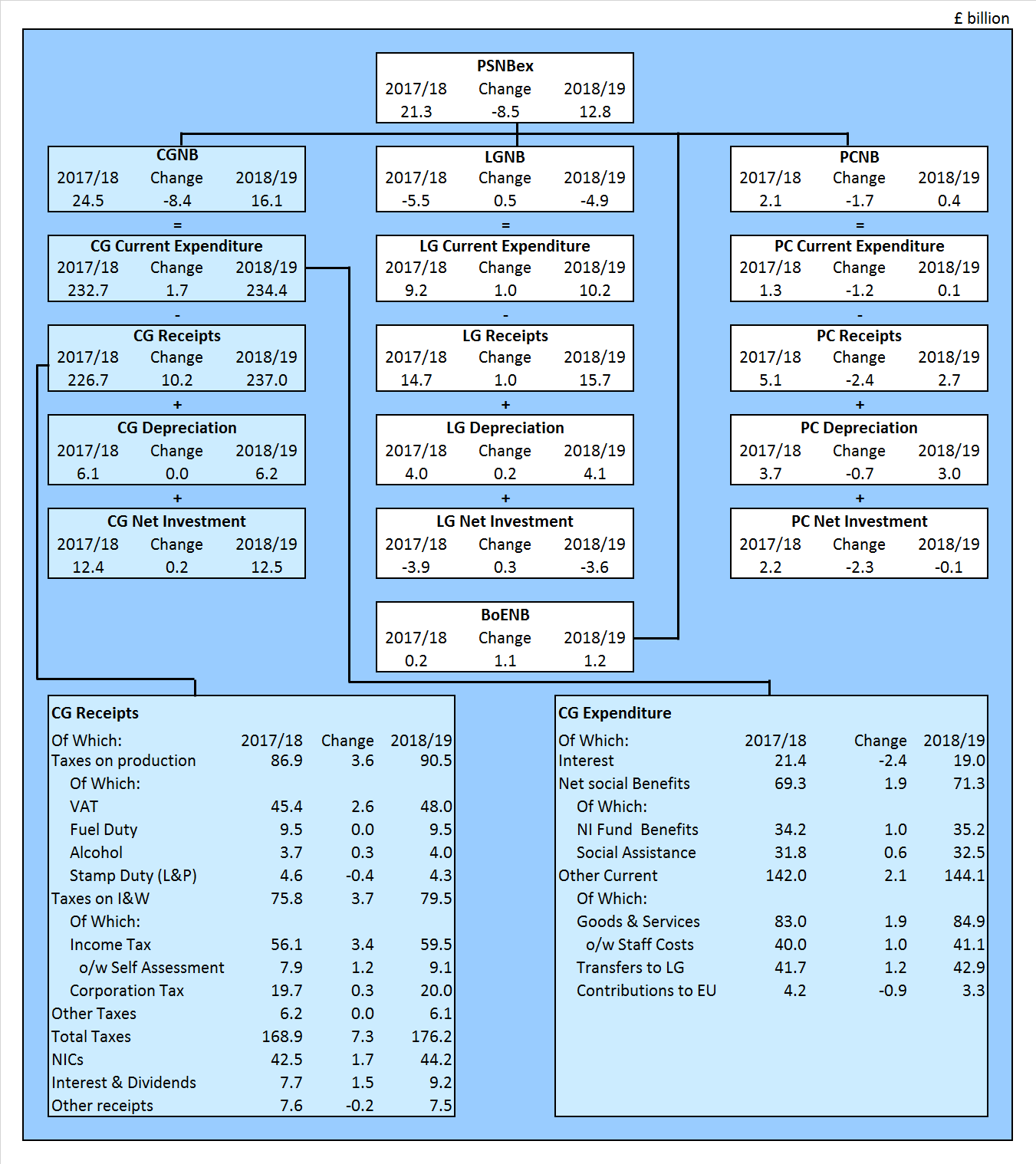
Source: Office for National Statistics
Notes:
PSNBex – Public sector net borrowing excluding public sector banks.
CGNB – Central government net borrowing.
LGNB – Local government net borrowing.
PCNB Non-financial public corporations net borrowing.
BoENB – Bank of England net borrowing.
L&P – Land and property.
I&W – Income and wealth.
Contributions to EU – UK VAT, GNI and abatement contributions to the EU budget.
NICs – National Insurance contributions.
Download this image Figure 3: Contributions to public sector net borrowing (excluding public sector banks) by sub-sector
.png (123.1 kB) .xls (87.6 kB)Figure 4 illustrates that annual borrowing has been falling generally since the peak in the financial year ending March 2010 (April 2009 to March 2010).
In the latest full financial year (April 2017 to March 2018), the £39.4 billion (or 1.9% of gross domestic product (GDP)) borrowed by the public sector was around one-quarter of PSNB ex in the financial year ending March 2010, when borrowing was £153.1 billion (or 9.9% of GDP).
Figure 4: Public sector net borrowing (excluding public sector banks)
April 1993 to July 2018, UK
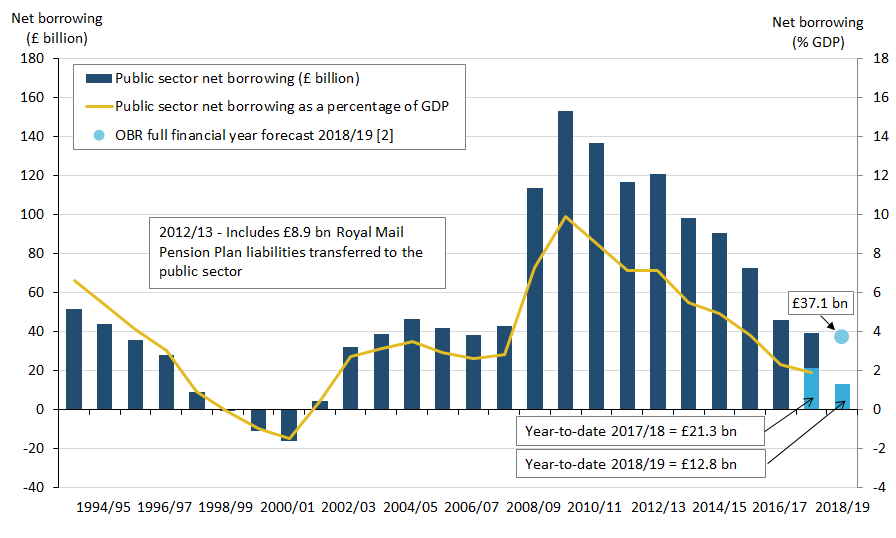
Source: Office for National Statistics
Notes:
Financial year 2017/18 represents the financial year ending 2018 (April 2017 to March 2018).
Office for Budget Responsibility (OBR) full financial year forecast of £37.1 billion for public sector net borrowing excluding public sector banks (March 2018 Economic and Fiscal Outlook).
Ytd equals year-to-date (April to July).
Download this image Figure 4: Public sector net borrowing (excluding public sector banks)
.png (42.7 kB) .xls (85.5 kB)The data for the latest month of every release contain some forecast data. The initial outturn estimates for the early months of the financial year, particularly April, contain more forecast data than other months, as profiles of tax receipts, along with departmental and local government spending are still provisional. This means that the data for these months are typically more prone to revision than other months and can be subject to sizeable revisions in later months.
Since the first estimate of PSNB ex for the financial year ending March 2018 (April 2017 to March 2018) was published on 24 April 2018, the estimate has been revised downward by £3.2 billion, from £42.6 billion to £39.4 billion. At this stage, of the data underlying the estimates of borrowing in the latest full financial year, only HMRC receipts data are audited.
Currently, for the financial year ending March 2018:
central government net borrowing comprises largely provisional data supplied by departments on the expenditure side and largely audited data (including HMRC Trust Statement data) on the receipts side
local government net borrowing is based on budget (forecast) data provided by the Ministry of Housing, Communities and Local Government (MHCLG) and the devolved administrations, updated where appropriate with in-year quarterly data published by MHCLG
public corporations’ net borrowing is based on Office for National Statistics (ONS) forecasts based on published Office for Budget Responsibility (OBR) data
Currently, for the financial year ending March 2017:
central government net borrowing comprises largely audited account data
local government data are mainly based on final outturn figures published by MHCLG and the devolved administrations
public corporations’ net borrowing is based on provisional returns from HM Treasury Whole of Government Accounts for the financial year ending March 2017, final outturn figures published by MHCLG, published accounts for individual public corporations and OBR forecasts
Appendix F shows revisions to the first reported estimate of financial-year-end public sector net borrowing (excluding public sector banks) by sub-sector. It summarises revisions to the first estimate of public sector net borrowing (excluding public sector banks) by sub-sector for the last six financial years. Revisions are shown at 6 and 12 months after year-end.
We have published an article, Public Sector Finances – Sources summary and their timing (PDF, 23KB), which provides a brief summary of the different sources used and the implications of using those data in the monthly Public sector finances (PSF) statistical bulletin.
Focusing on the latest month
In July 2018, the public sector received more money in taxes and other income than it spent, meaning that net borrowing was in surplus. The July surplus was £2.0 billion, a £1.0 billion greater surplus than in July 2017.
Key to the £1.0 billion growth in surplus were a £1.0 billion increase in self-assessed Income Tax receipts, a £0.4 billion increase in PAYE receipts and a £0.3 billion increase in VAT receipts. These were partially offset by an £0.8 billion increase in the central government departmental expenditure of goods and services.
In both January and July (though to a lesser extent), accrued receipts are particularly high due to receipts from self-assessed Income Tax. This month, receipts from self-assessed Income Tax were £9.0 billion, an increase of £1.0 billion on July 2017. This is the highest level of July self-assessed Income Tax receipts on record (records began in 1999). The revenue raised through self-assessed Income Tax, as well as primarily affecting January and July receipts, also tends to lead to higher receipts in the following month (February and August respectively), although to a lesser degree.
Figure 5 summarises public sector borrowing by sub-sector in July 2018 and compares this with the equivalent measures in the same month a year earlier (July 2017). This presentation splits public sector net borrowing excluding public sector banks (PSNB ex) into each of its four sub-sectors: central government, local government, public corporations and Bank of England.
In July 2018, central government received a £2.3 billion transfer from the Bank of England under the Asset Purchase Facility Scheme. This was £1.6 billion more than in July 2017. While this transfer lowered this month’s central government’s net borrowing by £2.3 billion, it raised Bank of England’s net borrowing by a corresponding amount, so having no effect at the public sector level.
Both local government and public corporations data for July 2018 are initial estimates. Most of these components are calculated by ONS based on OBR forecasts, with additional administrative source data used to estimate transfers to each of these sectors from central government.
Figure 5: Contributions to public sector net borrowing (excluding public sector banks) by sub-sector
July 2018, compared with July 2017, UK
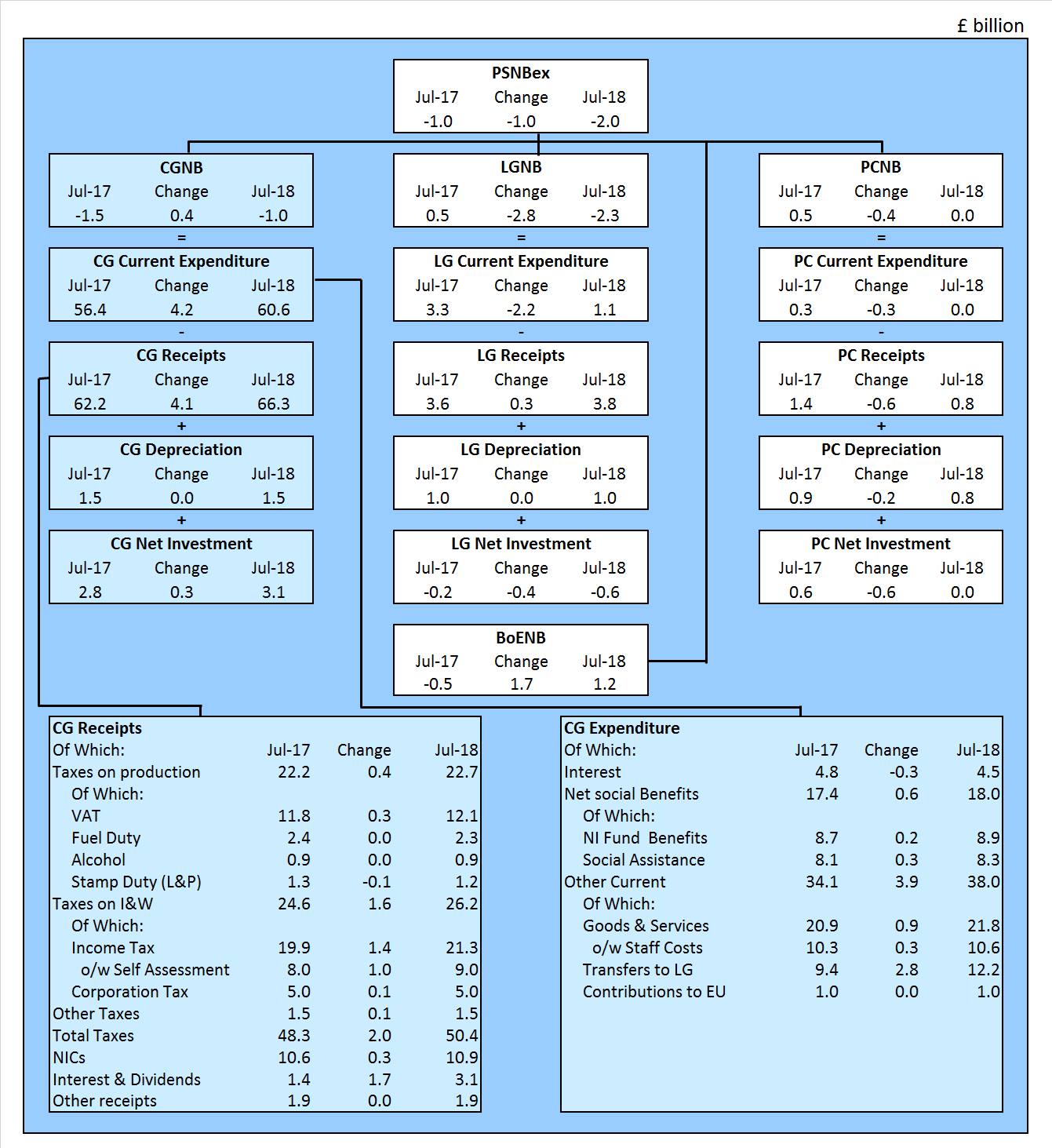
Source: Office for National Statistics
Notes:
PSNBex – Public sector net borrowing excluding public sector banks.
CGNB – Central government net borrowing.
LGNB – Local government net borrowing.
PCNB Non-financial public corporations net borrowing.
BoENB – Bank of England net borrowing.
L&P – Land and property.
I&W – Income and wealth.
Contributions to EU – UK VAT, GNI and abatement contributions to the EU budget.
NICs – National Insurance contributions.
Download this image Figure 5: Contributions to public sector net borrowing (excluding public sector banks) by sub-sector
.png (114.2 kB) .xls (87.6 kB)6. How much does the public sector owe?
At the end of July 2018, the amount of money owed by the public sector to the private sector stood at around £1.8 trillion, which equates to 84.3% of the value of all the goods and services currently produced by the UK economy in a year (or gross domestic product (GDP)).
This £1.8 trillion (or £1,777.5 billion) debt at the end of July 2018 represents an increase of £17.5 billion since the end of July 2017.
The introduction of the Term Funding Scheme (TFS) in September 2016 led to an increase in net debt, as the loans provided under the scheme are not liquid assets and therefore do not net off in public sector net debt (against the liabilities incurred in providing the loans).
Since July 2017, the net debt associated with Bank of England (BoE) increased by £48.1 billion to £192.9 billion. Nearly all of this growth was due to the activities of the Asset Purchase Facility, which includes £48.1 billion from the TFS.
The TFS closed for drawdowns of further loans on 28 February 2018 with a loan liability of £127.0 billion. The TFS loan liability at the end of July 2018 was £126.5 billion.
If we were to exclude the activities of the BoE in the estimation of public sector net debt (excluding public sector banks), it would reduce by £192.9 billion, from £1,777.5 billion to £1,584.6 billion, or from 84.3% of GDP to 75.2%.
Figure 6 breaks down outstanding public sector net debt at the end of July 2018 into the sub-sectors of the public sector. In addition to public sector net debt excluding public sector banks (PSND ex), this presentation includes the effect of public sector banks on debt.
Figure 6: Contributions to public sector net debt by sub-sector at the end of July 2018, UK
Source: Office for National Statistics
Notes:
PSND – Public sector net debt.
PSBsND – Public sector Banks net debt.
PSNDex – Public sector net debt excluding public sector banks.
BoEND – Bank of England's contribution to net debt.
PSND ex less BoE – Public sector net debt excluding both public sector banks and Bank of England.
NFPCND – Non-financial public corporations' net debt.
GGND – General government net debt.
Download this chart Figure 6: Contributions to public sector net debt by sub-sector at the end of July 2018, UK
Image .csv .xlsNet debt is defined as total gross financial liabilities less liquid financial assets, where liquid assets are cash and short-term assets, which can be released for cash at short notice without significant loss. These liquid assets comprise mainly foreign exchange reserves and bank deposits.
Figure 7 presents public sector net debt excluding public sector banks (PSND ex) at the end of July 2018 by sub-sector. Time series for each of these component series are presented in Tables PSA8A to D in the Public sector finances Tables 1 to 10: Appendix A dataset.
Figure 7: Contributions to public sector net debt (excluding public sector banks) by sub-sector at the end of July 2018, UK
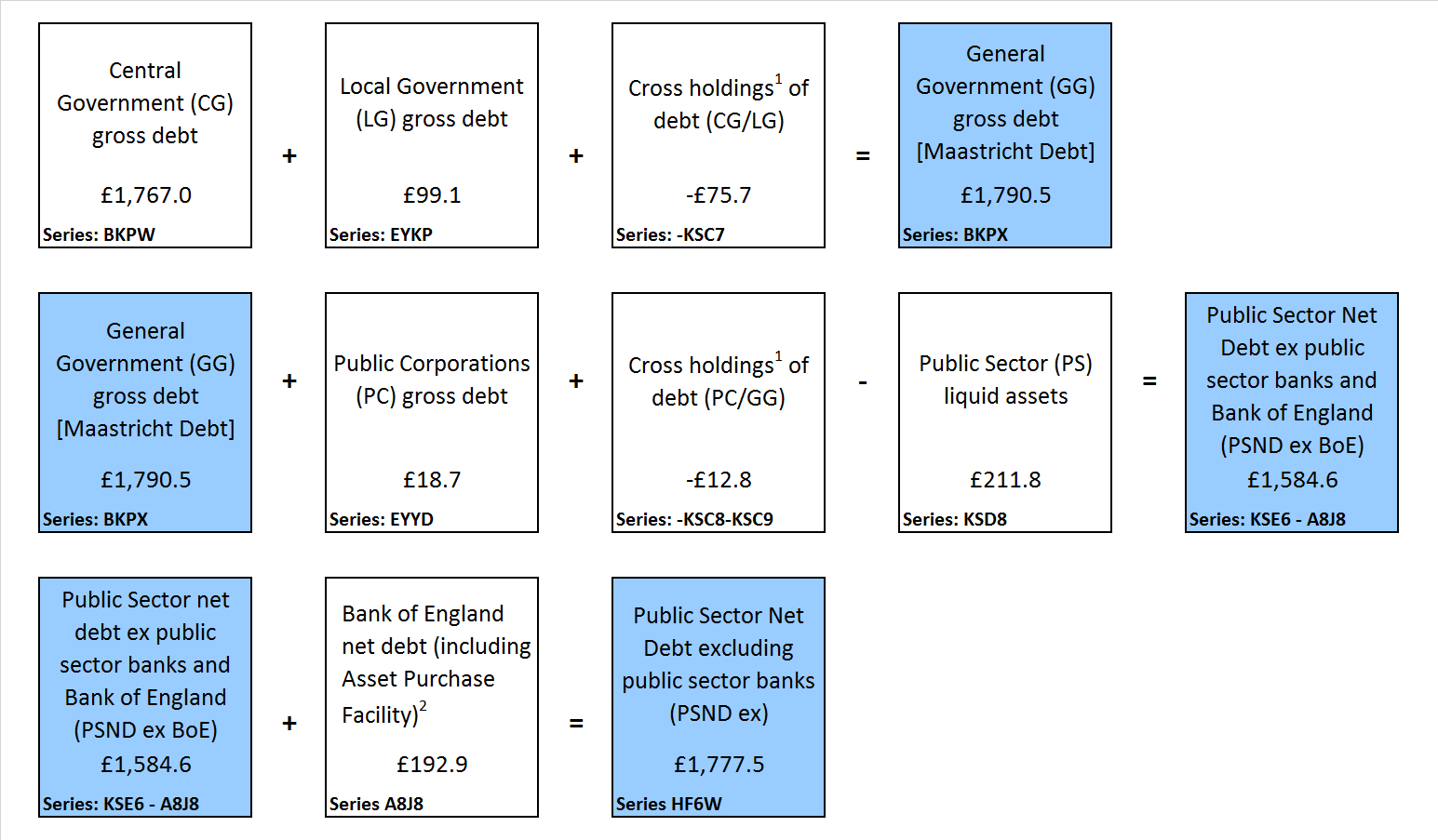
Source: Office for National Statistics
Notes:
Cross-holdings between sub-sectors are removed in calculating public sector net debt, gross debt and liquid assets.
APF – Bank of England Asset Purchase Facility.
Download this image Figure 7: Contributions to public sector net debt (excluding public sector banks) by sub-sector at the end of July 2018, UK
.png (73.4 kB) .xls (184.8 kB)Figure 8 illustrates PSND ex from the financial year ending March 1994 to the end of July 2018, highlighting the BoE contribution to net debt; due largely to its quantitative easing measures, through the activities of the Asset Purchase Facility (including the Term Funding Scheme).
Figure 8: Public sector net debt (excluding public sector banks)
March 1994 to the end of July 2018, UK
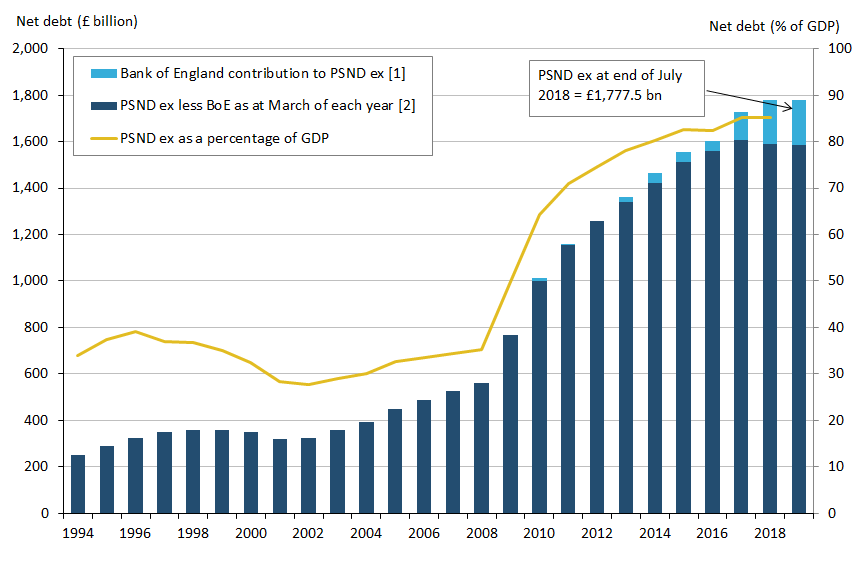
Source: Office for National Statistics
Notes:
Includes Asset Purchase Facility (APF), which includes the Term Funding Scheme (TFS).
Public sector net debt excluding public sector banks (PSND ex) is the combination of PSND ex Bank of England (BoE) plus BoE contribution to PSND ex.
Download this image Figure 8: Public sector net debt (excluding public sector banks)
.png (43.2 kB) .xls (67.1 kB)7. How much cash does the public sector need to raise?
The net cash requirement is a measure of how much cash the public sector needs to raise from the financial markets (or pay out from its cash reserves) to finance its activities. This amount can be close to net borrowing for the same period but there are some transactions, for example, lending to the private sector or the purchase of shares, that need to be financed but do not contribute to net borrowing. Similarly, repayments of principal on loans extended by government or sales of shares will reduce the level of financing necessary but not reduce the net borrowing.
Figure 9 presents public sector cash requirement by sub-sector in the current financial year-to-date (April to July 2018). Time series for each of these component series are presented in Table PSA7A in the Public sector finances Tables 1 to 10: Appendix A dataset.
Figure 9: Contributions to public sector net cash requirement (excluding public sector banks) by sub-sector
Current financial year-to-date (April to July 2018), UK
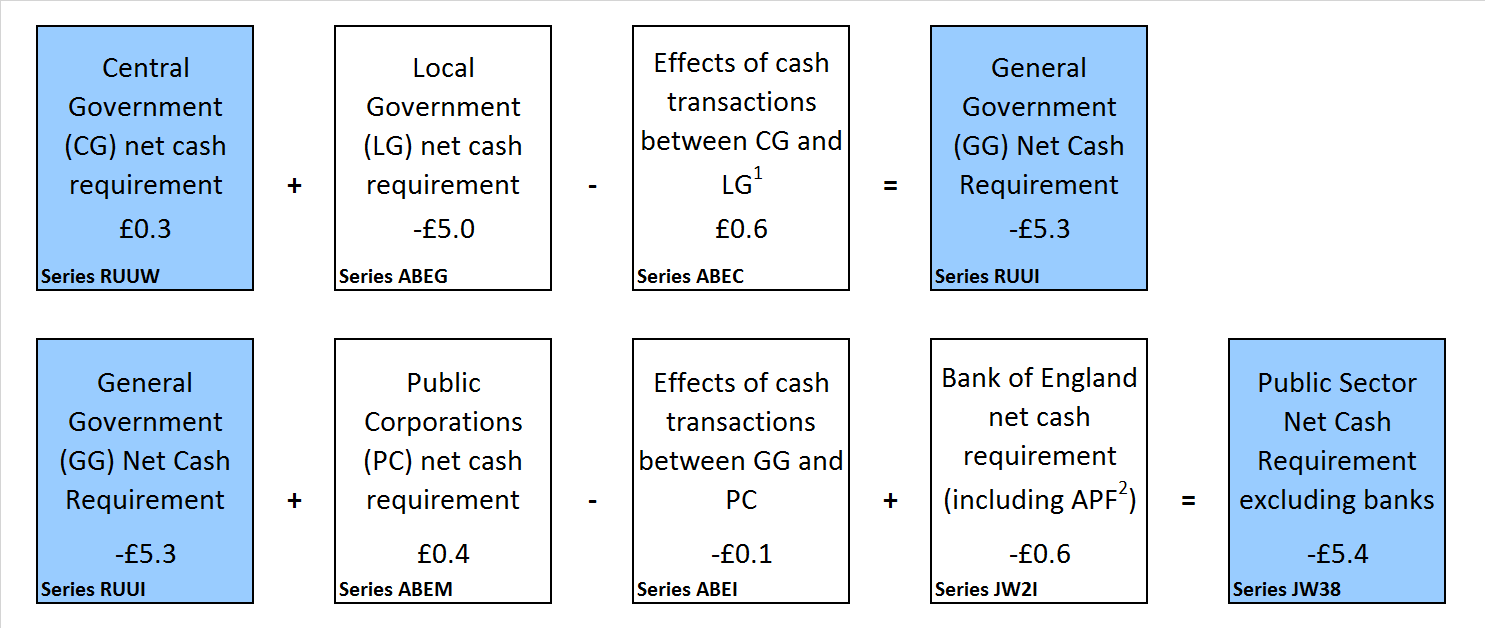
Source: Office for National Statistics
Notes:
Effects of cash transactions between sub-sectors are removed in calculating public sector total net cash requirement (and consolidated expenditure and income totals).
APF – Bank of England Asset Purchase Facility.
Download this image Figure 9: Contributions to public sector net cash requirement (excluding public sector banks) by sub-sector
.png (52.6 kB) .xls (170.5 kB)Central government net cash requirement (CGNCR) is a focus for some users, as it provides an indication of the volume of gilts (government bonds) the Debt Management Office may issue to meet the government’s borrowing requirements.
In the current financial year-to-date (April to July 2018), CGNCR was £0.3 billion, that is, £4.4 billion less than in the previous year.
In the current financial year, central government received £8.6 billion in cash terms from the sale of assets (£1.4 billion in spectrum licences, £5.3 billion in UK Asset Resolution (UKAR) mortgage assets and £2.5 billion in Royal Bank of Scotland (RBS) shares); while over the same period in 2017, this figure stood at £12.8 billion (£11.8 billion of UKAR mortgage assets).
CGNCR is quoted both including and excluding the net cash requirement of Network Rail (NR) and UKAR, which manages the closed mortgage books of both Bradford and Bingley, and Northern Rock Asset Management. It is the CGNCR excluding NR and UKAR that is the particular focus of users with an interest in the gilt market.
CGNCR excluding NR and UKAR decreased by £4.6 billion to £0.6 billion in the current financial year-to-date (April to July 2018), compared with the same period in 2017.
Nôl i'r tabl cynnwys8. How was debt in the latest financial year accumulated?
Figure 10 brings together the borrowing components detailed in Figure 3 to illustrate how the differences between income and spending (both current and capital) have led to the accumulation of debt in the current financial year-to-date (April to July 2018).
This presentation excludes public sector banks, focusing instead on the public sector net borrowing excluding public sector banks (PSNB ex) measure.
The reconciliation between public sector net borrowing and net cash requirement is presented in more detail in Table REC1 in the Public sector finances Tables 1 to 10: Appendix A dataset.
Figure 10: Components of net debt
How the difference in expenditure and receipts affect public sector net debt (excluding public sector banks), UK
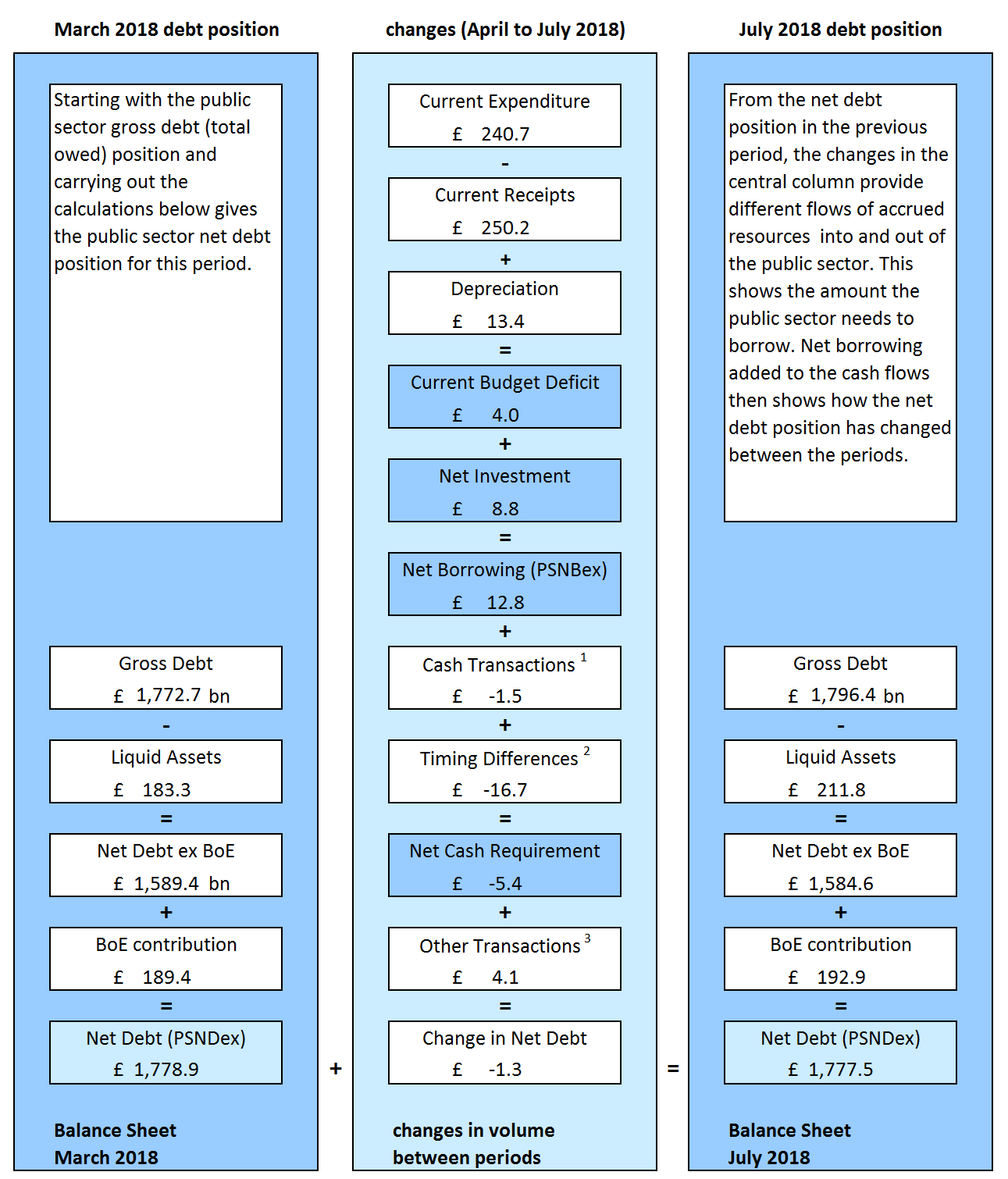
Source: Office for National Statistics
Notes:
Cash transactions in (non-financing) financial assets, which do not impact on net borrowing.
Timing differences between cash and accrued data.
Revaluation of foreign currency debt (for example, foreign currency). Debt issuances or redemptions above or below debt valuation (for example, bond premia and discounts and capital uplifts). Changes in volume of debt not due to transactions (for example, sector reclassification).
Download this image Figure 10: Components of net debt
.png (131.6 kB) .xls (60.9 kB)9. How do these figures compare with official forecasts?
The Office for Budget Responsibility (OBR) normally produces forecasts of the public finances twice a year (currently in March and November). The government has adopted OBR forecasts as its official forecast.
OBR forecasts used in this bulletin are based on those published on 13 March 2018.
Public sector net borrowing (excluding public sector banks) in the financial year ending March 2018 was £39.4 billion; that is, £6.4 billion less than in the previous financial year (April 2016 to March 2017) and £5.8 billion less than the £45.2 billion forecast by OBR. However, this £39.4 billion represents our fifth estimate and will be revised over the coming months as we continue to replace our initial estimates with provisional and then final outturn data.
Over the financial year ending March 2019, OBR expects the public sector to borrow £37.1 billion; around one-quarter of what it borrowed between March 2009 and April 2010, at the peak of the financial crisis.
Figure 11 presents the cumulative public sector net borrowing for the latest full financial year. The figure also presents the OBR forecasts for the current financial year (April 2018 to March 2019), as well as the cumulative borrowing in the current financial year-to-date (April to July 2018).
The monthly path of spending and receipts is not smooth within the financial year and also can vary compared with previous years, both of which can affect year-on-year comparisons.
Figure 11: Public sector net borrowing (excluding public sector banks)
Cumulative financial year-to-date (April to July 2018) compared with the financial year ending March 2018 (April 2017 to March 2018), UK
Source: Office for National Statistics
Notes:
For the financial year ending 2018 (April 2017 to March 2018).
For the financial year-to-date ending 2019 (April to July 2018).
OBR forecast for public sector net borrowing excluding public sector banks from March 2018 Economic and Fiscal Outlook (EFO).
Download this chart Figure 11: Public sector net borrowing (excluding public sector banks)
Image .csv .xlsTable 1 compares the current outturn estimates for each of our main public sector (excluding public sector banks) aggregates for the latest full financial year with corresponding OBR forecasts for the following financial year. Further, it compares the current financial year-to-date (April to July 2018) outturn estimates with those of the previous financial year.
Caution should be taken when comparing public sector finances data with OBR figures for the full financial year. Data are not finalised until sometime after the financial year ends, with initial estimates made soon after the end of the financial year often subject to sizeable revisions in later months as forecasts are replaced with audited outturn data.
There may also be known methodological differences between OBR forecasts and outturn data.
Table 1: Latest outturn estimates compared with Office for Budget Responsibility forecasts
| Office for Budget Responsibility (OBR) forecasts in the current financial year-to-date (April to July 2018) compared with the latest full financial year (April 2017 to March 2018), UK | ||||||
| Excluding public sector banks | £ billion1 (not seasonally adjusted) | |||||
| Financial year-to-date7 | Full financial year8 | |||||
|---|---|---|---|---|---|---|
| 2017/18 | 2018/19 | % change | 2017/18 Outturn | 2018/19 OBR Forecast9 | % change | |
| Current budget deficit2 | 10.6 | 4.0 | -62.7 | -1.2 | -1.9 | 59.1 |
| Net investment3 | 10.7 | 8.8 | -17.3 | 40.6 | 39.0 | -4.0 |
| Net borrowing 4 | 21.3 | 12.8 | -40.0 | 39.4 | 37.1 | -6.0 |
| Net debt 5 | 1,760.0 | 1,777.5 | 1.0 | 1,778.9 | 1,835.0 | 3.2 |
| Net debt as a percentage of GDP6 | 86.0 | 84.3 | NA | 85.3 | 85.5 | NA |
| Source: Office for National Statistics | ||||||
| Notes: | ||||||
| 1. Unless otherwise stated. | ||||||
| 2. Current budget deficit is the difference between current expenditure (including depreciation) and current receipts. | ||||||
| 3. Net investment is gross investment (net capital formation plus net capital transfers) less depreciation. | ||||||
| 4. Net borrowing is current budget deficit plus net investment. | ||||||
| 5. Net debt is financial liabilities (for loans, deposits, currency and debt securities) less liquid assets. | ||||||
| 6. GDP at current market price. | ||||||
| 7. Financial year-to-date refers to the period from April to July. | ||||||
| 8. 2018/19 refers to financial year ending in March 2019 and 2017/18 refers to financial year ending in March 2018. | ||||||
| 9. All OBR figures are from the OBR Economic and Fiscal Outlook published in March 2018. | ||||||
| 10. NA means "not applicable". | ||||||
Download this table Table 1: Latest outturn estimates compared with Office for Budget Responsibility forecasts
.xls (50.2 kB)10. Revisions since previous release
Revisions can be the result of both updated data sources and methodology changes. This month, the reported revisions are as a result of updated data sources only.
It is important to note that revisions do not occur as a result of errors; errors lead to corrections and are identified as such when they occur. This month we have no errors to report.
Table 2 presents the revisions to the headline statistics presented in this bulletin compared with those presented in the previous publication (published on 20 July 2018).
Table 2: Revisions to main aggregates
| Revisions since the previous public sector finances bulletin (published 20 July 2018), UK | ||||||||
| £ billion1 (not seasonally adjusted) | ||||||||
| Net borrowing | ||||||||
|---|---|---|---|---|---|---|---|---|
| Period | CG2 | LG3 | NFPCs4 | BoE5 | PSNB ex6 | PSND ex7 | PSND % of GDP | PSNCR ex8 |
| 2015/16 | 0.0 | 0.0 | 0.0 | 0.0 | 0.0 | 0.0 | 0.0 | 0.0 |
| 2016/17 | 0.1 | 0.0 | 0.0 | 0.0 | 0.1 | 0.0 | 0.0 | 0.0 |
| 2017/18 | 0.1 | 0.0 | 0.0 | 0.0 | 0.1 | 0.0 | 0.0 | -0.9 |
| 2018/19 YTD | -2.2 | 0.2 | 0.0 | 0.0 | -2.0 | -1.1 | 0.0 | 0.2 |
| 2018 April | -0.8 | 0.1 | 0.0 | 0.0 | -0.7 | 0.1 | 0.1 | 0.0 |
| 2018 May | -0.2 | 0.1 | 0.0 | 0.0 | -0.1 | -0.4 | 0.0 | 0.0 |
| 2018 Jun | -1.3 | 0.1 | 0.0 | 0.0 | -1.2 | -1.1 | 0.0 | 0.1 |
| Source: Office for National Statistics | ||||||||
| Notes: | ||||||||
| 1. Unless otherwise stated. | ||||||||
| 2. Central government. | ||||||||
| 3. Local government. | ||||||||
| 4. Non-financial public corporations. | ||||||||
| 5. Bank of England. | ||||||||
| 6. Public sector net borrowing excluding public sector banks. | ||||||||
| 7. Public sector net debt excluding public sector banks. | ||||||||
| 8. Public sector net cash requirement excluding public sector banks. | ||||||||
| 9. 2017/18 represents financial year ending 2018 (April 2017 to March 2018). | ||||||||
| 10. 2018/19 YTD refers to the current financial year-to-date (April to June 2018). | ||||||||
Download this table Table 2: Revisions to main aggregates
.xls (52.2 kB)Revisions to public sector net borrowing (excluding public sector banks) in the current financial year-to-date (April to June 2018)
The data for the latest month of every release contain some forecast data. The initial outturn estimates for the early months of the financial year, particularly April, contain more forecast data than other months, as profiles of tax receipts, along with departmental and local government spending are still provisional. This means that the data for these months are typically more prone to revision than other months and can be subject to sizeable revisions in later months.
Public sector net borrowing excluding public sector banks (PSNB ex) has been revised down by £2.0 billion compared with figures presented in the previous bulletin (published on 20 July 2018).
Of this £2.0 billion downward revision to PSNB ex, there was a £2.2 billion reduction in the estimate of central government net borrowing, partially offset by a £0.2 billion increase in the estimation of local government’s contribution to net borrowing.
Central government receipts were revised upwards by £1.3 billion, with increases in previous estimates of Value Added Tax, Income Tax, interest (and dividends) and National Insurance contributions of £0.4 billion, £0.3 billion, £0.3 billion and £0.2 billion respectively.
In the same period, both central government current and capital expenditure were revised downwards by £0.7 billion and £0.2 billion respectively.
Revisions to central government current expenditure were largely the result of updated departmental expenditure data, with expenditure on goods and services and current transfers to local government decreasing by £0.3 billion and £0.2 billion respectively.
Figure 12 breaks down this revision to PSNB ex by each of its four sub-sectors: central government, local government, non-financial public corporations and Bank of England (BoE).
The figure also provides a further breakdown of central government current receipts and current expenditure reflecting the significance of these components within borrowing at a public sector level.
Figure 12: Revisions to net borrowing
Latest data covering April to June 2018, compared with that presented in the previous bulletin (20 July 2018), UK
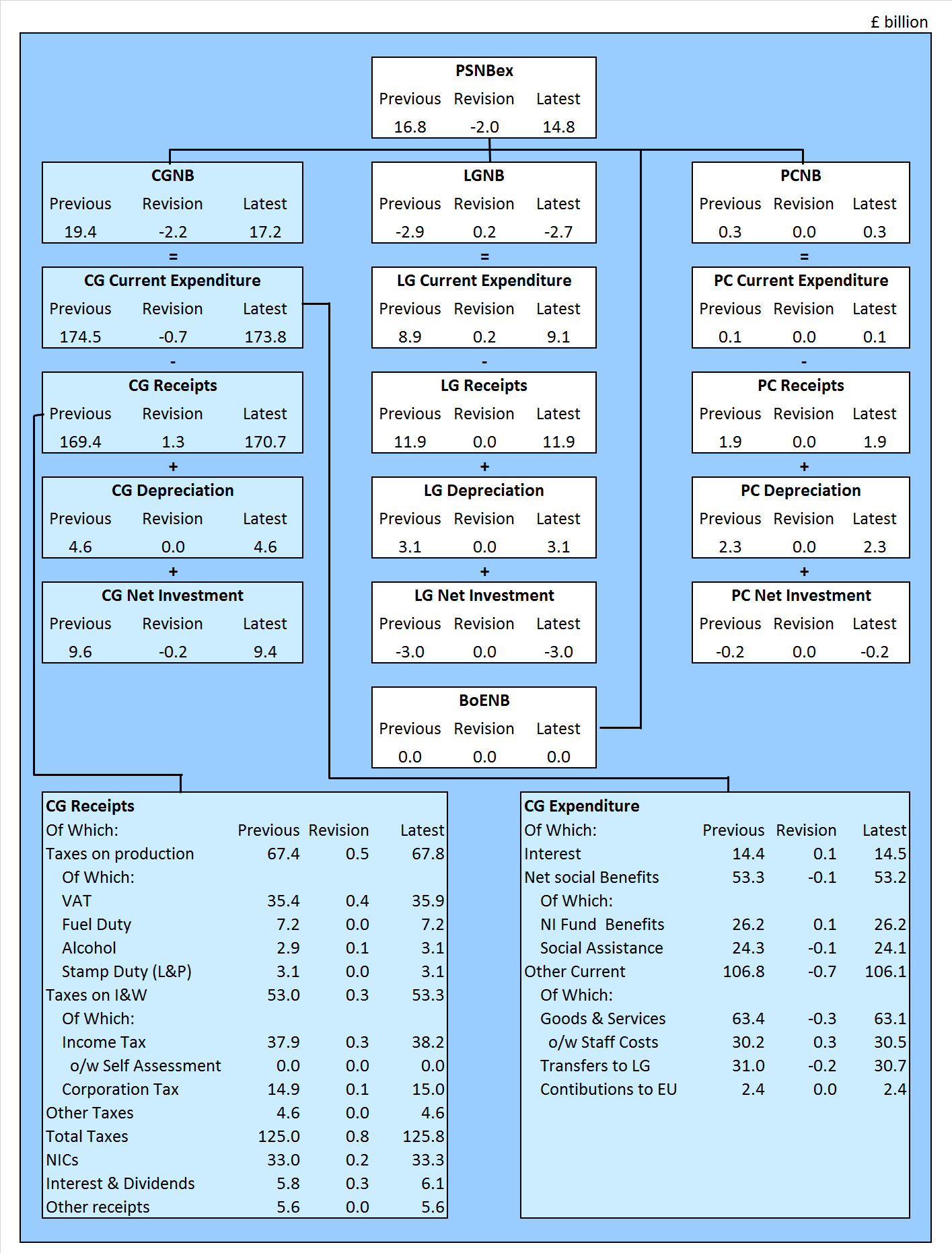
Source: Office for National Statistics
Notes:
PSNBex – Public sector net borrowing excluding public sector banks.
CGNB – Central government net borrowing.
LGNB – Local government net borrowing.
PCNB Non-financial public corporations net borrowing.
BoENB – Bank of England net borrowing.
L&P – Land and property.
I&W – Income and wealth.
Contributions to EU – UK VAT, GNI and abatement contributions to the EU budget.
NICs – National Insurance contributions.
Download this image Figure 12: Revisions to net borrowing
.png (144.7 kB) .xls (89.1 kB)Revisions to public sector net debt (excluding public sector banks)
This month we have decreased our estimate of public sector net debt (excluding public sector banks) as at the end of July 2018, by £1.1 billion. This revision was due in part to an increase of £0.5 billion in our estimate of government liquid assets and in part, to a £0.6 billion decrease in our estimate of Bank of England’s contribution to net debt.
Nôl i'r tabl cynnwys11. International comparisons of debt and deficit
The UK government debt and deficit statistical bulletin is published quarterly (in January, April, July and December each year), to coincide with when the UK and other EU member states are required to report on their deficit (or net borrowing) and debt to the European Commission.
On 17 July 2018, we published UK government debt and deficit: March 2018, consistent with Public sector finances, UK: May 2018 (published on 21 June 2018). In this publication we stated that:
general government gross debt was £1,763.8 billion at the end of March 2018, equivalent to 85.8% of gross domestic product (GDP); 25.8 percentage points above the Maastricht reference value of 60.0%
general government deficit (or net borrowing) was £40.7 billion in the financial year ending March 2018, equivalent to 2.0% of GDP; 1.0 percentage point below the Maastricht reference value of 3.0%
The UK general government debt and deficit data we published on 17 July 2018 were published by Eurostat on 20 July 2018 in context with the other 27 EU member states.
This bulletin presents largely unchanged figures compared with those published on 17 July 2018, with general government deficit (or net borrowing) in the financial year ending March 2018 reducing by £0.1 billion to £40.6 billion.
It is important to note that the GDP measure, used as the denominator in the calculation of the debt ratios in the UK government debt and deficit statistical bulletin, differs from that used within the Public sector finances statistical bulletin.
Nôl i'r tabl cynnwys12. Quality and methodology
The public sector finances Quality and Methodology Information (QMI) report contains important information on:
the strengths and limitations of the data and how it compares with related data
uses and users of the data
how the output was created
the quality of the output including the accuracy of the data
The public sector finances methodological guide provides a comprehensive contextual and methodological information concerning the monthly Public sector finances statistical bulletin.
The guide sets out the conceptual and fiscal policy context for the bulletin, identifies the main fiscal measures and explains how these are derived and inter-related. Additionally, it details the data sources used to compile the monthly estimates of the fiscal position.
Nôl i'r tabl cynnwys13. Looking ahead
This section presents information on aspects of data or methodology that are planned but not yet included in the public sector finances.
Further, in our article Looking ahead: developments in public sector finance statistics, we provide users with early sight of those areas where the fiscal statistics may be significantly impacted upon by methodological or classification changes during the coming 24 months.
Recent announcements concerning the Term Funding Scheme
On the 21 June 2018, the government published a new Memorandum of Understanding between HM Treasury and the BoE, which sets out the financial relationship between the two institutions.
This memorandum announced (PDF, 1.42MB) that during the current financial year (April 2018 to March 2019), the £127 billion liabilities of the Term Funding Scheme (TFS) will be transferred from the Bank of England Asset Purchase Facility Fund (APF) to the Bank’s own balance sheet and that the HM Treasury indemnity for it was being removed.
TFS was introduced in 2016 as a quantitative easing measure under the APF umbrella, to enable financial institutions to cut the time in passing on interest rate reductions to consumers and businesses.
This change will have no impact on public sector net debt (both including and excluding public sector banks).
Further, to enable the Bank to take TFS on balance sheet without an indemnity from the Treasury, a capital injection of £1.2 billion from HM Treasury to the Bank has been announced. The nature of the capital injection will be formally discussed at a classifications meeting and announced in due course.
Ministry of Defence inventories
The Ministry of Defence has been granted a one-off amnesty to remove obsolete items from its balance sheet in the financial year ending March 2018. Latest estimates (PDF, 613KB) suggest that this could result in the writing-off or disposal of up to £0.5 billion worth of obsolete items.
We are working with the Ministry of Defence to source the data we need to ensure that the impacts of this amnesty are fully reflected in the public sector finances.
East Coast Mainline
On 16 May 2018, the government announced that from 24 June 2018, London North Eastern Railway (LNER) will take over the running of East Coast Mainline services. We are currently investigating the implications of this decision and our conclusions will be announced in due course.
EU withdrawal agreement
On 8 December 2017, the government published a joint report on progress during phase 1 of negotiations between the European Union and the UK (PDF, 383KB), under Article 50 of the Treaty on European Union (TEU) on the UK’s orderly withdrawal from the EU.
Although the Office for Budget Responsibility (OBR) discusses the EU settlement in Annex B (PDF, 2.5MB) of their Economic and fiscal outlook – March 2018, the details in the report are still subject to negotiation and so there is insufficient certainty at this stage for us to complete a formal assessment of impact on the UK public sector finances.
Carillion insolvency
Following Carillion Plc declaring insolvency on 15 January 2018, the UK government announced that it will provide the necessary funding required by the Official Receiver, to ensure continuity of public services through an orderly liquidation. The Official Receiver has been appointed by the court as liquidator, along with partners at PwC that have been appointed Special Managers. The defined benefit pension schemes of former Carillion employees are currently being assessed by the Pension Protection Fund (PPF) prior to any transition into the PPF scheme.
We are currently investigating the various impacts of the liquidation of Carillion on the public sector finances, including in relation to the public-private partnership projects in which Carillion was involved and the additional funding that the government has provided in order to maintain public services. We will announce our findings in due course.
Prior to liquidation, Carillion held approximately 450 contracts with government, representing 38% of Carillion’s 2016 reported revenue.
HMRC Data
We are currently reviewing our recording of VAT refund data, in collaboration with HM Revenue and Customs and HM Treasury. VAT refunds provide an estimate of the amount of VAT claimed back by local authorities and central government departments. Given that this tax is also recorded as expenditure by each local authority and central government department, these receipts net out at a general government level and have no impact on public sector net borrowing.
Further, we are investigating our recording of fines and penalties for the late payment of taxes. Any additional revenue identified and recorded by the inclusion of such payments would increase central government receipts and so reduce public sector net borrowing.
Nôl i'r tabl cynnwys14. Background information
All data contained within these publications are available to download via the public sector finances time series dataset. From April 1997 to date, where available, time series are presented as monthly data, with series extending further back in time, generally presented on a quarterly or financial year basis.
Time series exclusive to the public sector finances borrowing by sub-sector presentation are only available as quarterly time series, though these extend back to 1946.
Supporting documentation
Documentation supporting this publication is available in appendices to the bulletin:
Large impacts on public sector fiscal measures excluding banking groups: Appendix B
Public sector finances revisions analysis on main fiscal aggregates: Appendix C
Impact of the reclassification of housing associations into the public sector: Appendix E
Revisions to the first reported estimate of public sector net borrowing: Appendix F
Public sector borrowing by sub-sector
Each month, at 9:30am on the working day following the Public sector finances statistical bulletin, we publish Public sector finances borrowing by sub-sector. This release contains an extended breakdown of public sector borrowing in a matrix format and also estimates of total managed expenditure (TME).
Nôl i'r tabl cynnwys
